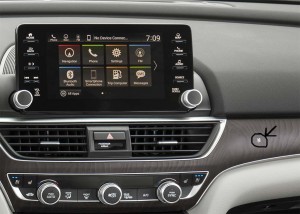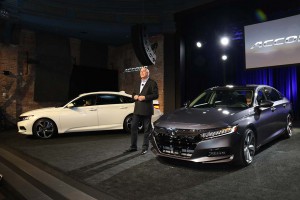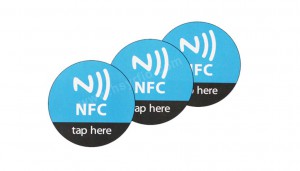(This story has been updated to note that Mercedes-Benz is now offering NFC in some versions of its new E-Clas line.)
Bluetooth? Meh. In-car WiFi? Ancient history. Automakers are just starting to roll out a new wireless technology that could offer motorists a number of advantages.
It’s known as Near Field Communications, or NFC for short, and if you have a relatively recent smartphone you might already know some of its uses. Among other things, NFC is the system used by Apple for its iPhone payment system.
Automakers have been talking about adding the technology for a number of years. But NFC is really only now getting a ride, the technology showing up on the 2018 Honda Accord introduced last week, with several other models set to add the technology in the near future.
(BMW expands list of features with new BMW Connected + service. For more, Click Here.)
You’ll find a symbol – a stylized “N” — for the new technology on the instrument panel of the new Accord, in front of the passenger seat. And it “will make your life just a little bit easier if you happen to use an Android smartphone,” explained Sam Abuelsamid, an analyst with Navigant Research, in an article he’s written for Forbes.
Why Android? It has already integrated a number of functions that can use NFC, while its smartphone rival has so far limited the use of the technology to its Apple Pay service.
What’s the difference between WiFi, Bluetooth and NFC? All three are wireless communications systems and they can share some features and functions:
- WiFi is the big dog in the group, capable of providing two-way links to lots of different devices simultaneously, at relatively long range. It can handle enough data to stream HD video (in some cases, several streams simultaneously, and it will soon allow over-the-air updates for onboard software. A growing number of vehicles already include WiFi capabilities;
- Bluetooth has a more limited range and can’t stream data quite as quickly. It is most commonly used in a vehicle to pair a smartphone to the car’s audio and hands-free phone system;
- NFC is the lowest-power technology of the three and might be thought of as something of a portable key. It can be used, in fact, as a portable key, instead of using a wireless keyfob, and it can be used to create and store personal vehicle settings that can be carried from one car to another. It also can be used to link different devices in the vehicle itself, instead of using WiFi.
In fact, Near Field Communications technology also can serve as a digital handshake between the three different wireless systems. Tap your Android smartphone on the “N” logo when you get into the new Accord for the first time and it will instantly pair up the Bluetooth system. That’s similar to the way you can use NFC to make a purchase, much like you do with Apple Pay or Android Pay.
As Abuelsamid notes, Apple is reportedly looking at enabling more NFC capabilities when it brings out the eagerly awaited iPhone 8 later this year.
(Continental races to keep up with rapidly changing onboard technology. Click Here for the story.)
BMW introduced NFC in a mobile application in 2012 but hasn’t done much with the technology, perhaps because there have so far been relatively few applications for it. With the Bavarian maker set to introduce a new version of its connected services platform, the newly renamed BMW Connected Plus, we may start to see more.
Mercedes-Benz also offers NFC for pairing phones on new E-Class models equipped with the Premium 1 Package “or higher,” according to a spokesman.
Honda is the first to go mainstream with the technology, however, and is expected to roll it out across the line-up as it upgrades its infotainment technology.
Whether other manufacturers will follow is unclear. Research firm IHS recently noted that the technology has so far taken a decade to roll out and is only “finally gain(ing) traction in the mobile device sector.” It predicts significant growth in smartphone applications, though “such fast growth has yet to be seen in the automotive industry.”
But Honda may finally provide the impetus that cracks this chicken-and-egg problem. With a major automaker now offering NFC more applications will be developed, encouraging still more automakers to get onboard.
(Autonomous vehicle development gets boost from FCC. Click Here for the story.)




Hi Paul,
I’ve been following you on Twitter. Lots of good stuff. I never tweet, don’t know how, don’t need to know. I’m wondering about all the things showing up on dashboards these days, such as the Honda you discuss here. My ’08 Accord has a clock, radio station ID and song ID. That seems to be enough for me. Won’t all these other screens just create more driver distraction? If I do end up buying a new car, can I turn off and never see all this stuff, except for the radio ID and clock?
Keep up the good work,
Tom
Hi, Tom,
Thanks for the kind words!
As to driver distraction, that’s a big question mark. The maker’s insist that by putting things on HUD or the center stack there will be less distraction than on a handheld device. They also can control what is and what ISN’T displayed while the vehicle is moving. That was a point stressed by the BMW folks at the session on the new BMW Connected + I wrote about last week. Here’s the link: http://www.thedetroitbureau.com/2017/07/bmw-hopes-to-stay-connected-with-consumers-in-a-new-digital-era/
All best,
Paul E.